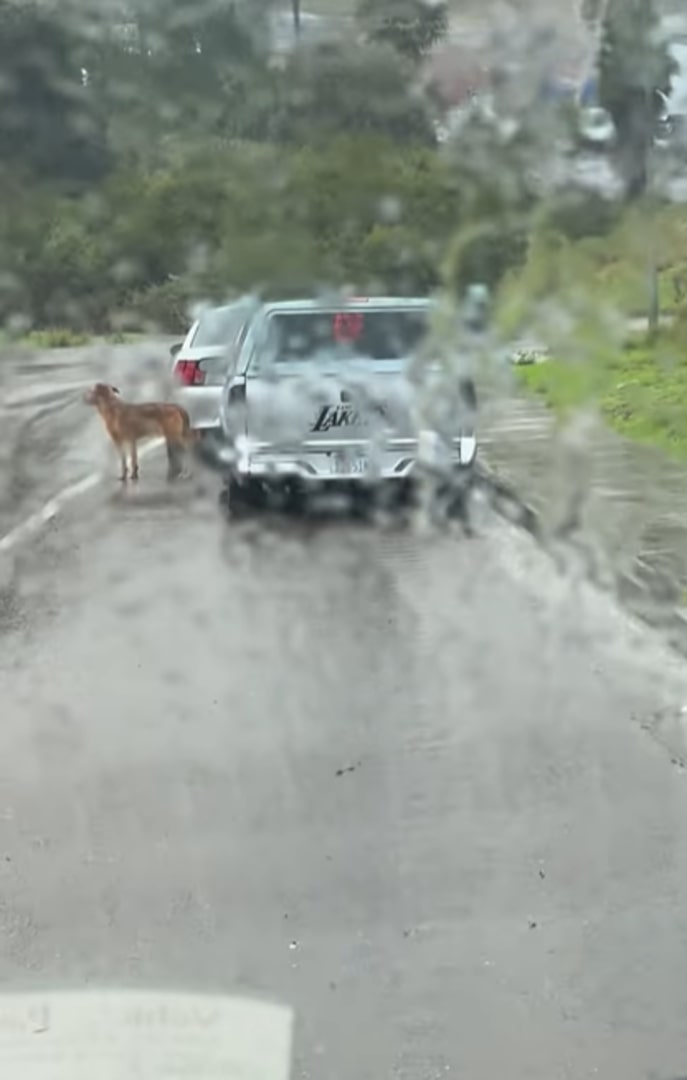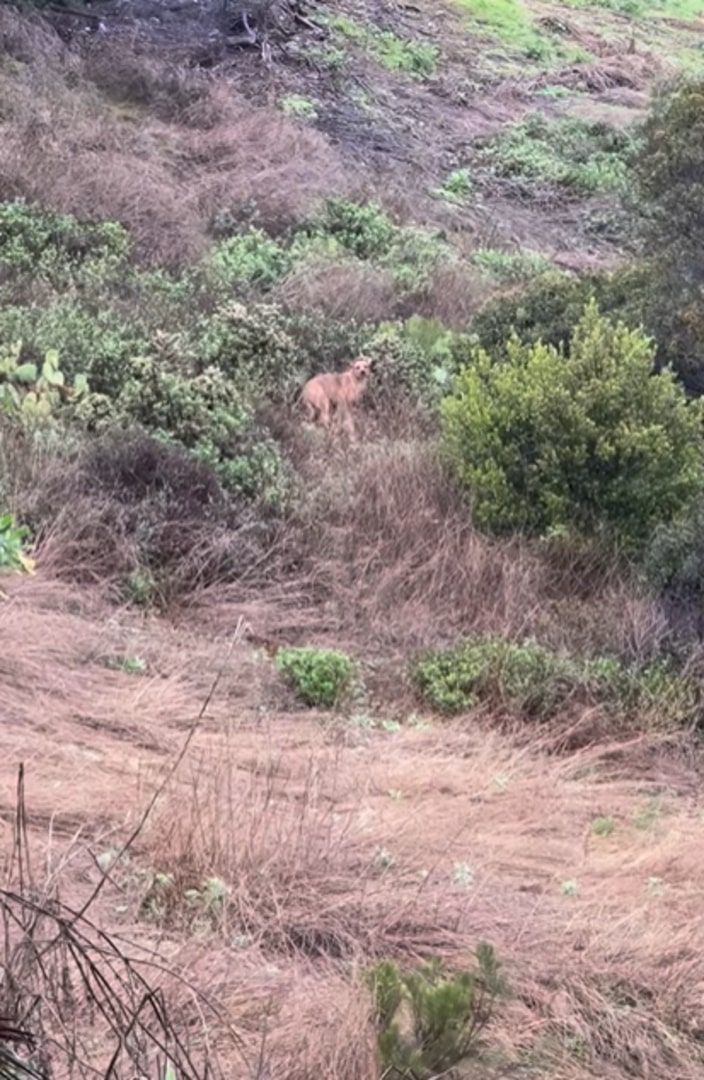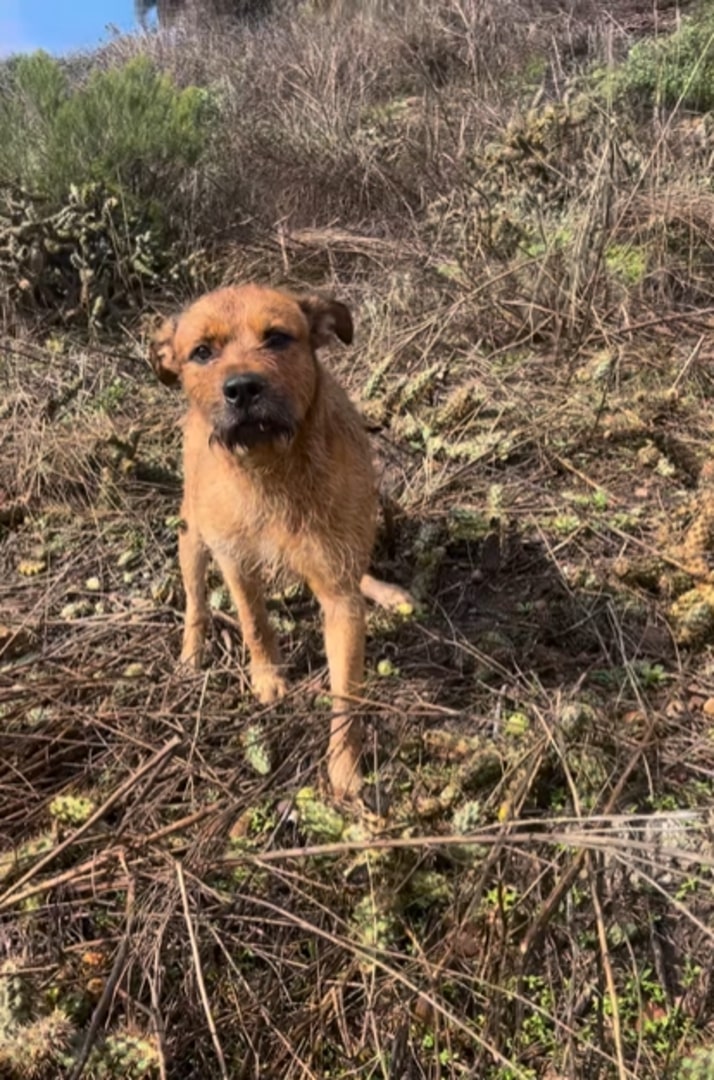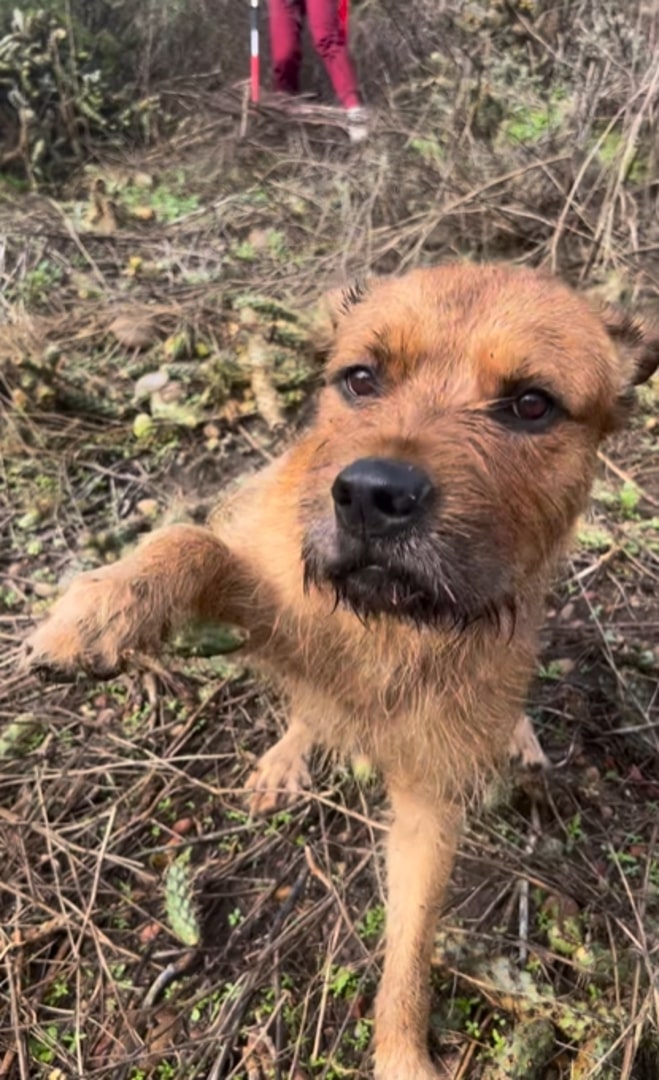Pete’s life was everything but sweet.
When this sweet boi got out of the car on a cold, rainy day, never in his worst dreams could he imagine that would be the last time he would see his owner. Then, the door closed, the man drove away, and Pete got left in confusion.
For things to be worse, he sat there for six straight hours, moments before a Tornado warning came out.
Pete Survived Shocking Circumstances

A witness reached out to The Heroic Tail Rescue, from San Diego, California, when they saw Pete. There was a man throwing him out of the car on the road, but instead of driving away immediately, he stayed in the car and slept there for a while.
That’s when the real tragedy happened!
A passing truck hit Pete, which made the kind person confront the owner. Even though the owner claimed that he didn’t give up on his dog, he drove away only minutes later, and he never came back!
“A car had hit Pete and he was laying on the side of the road getting rained on. This person was trying to help him but couldn’t get close because Pete would growl and bark at him,” The Heroic Tail Dog Rescue wrote in an Instagram post.

In the meantime, the kind passerby tried contacting animal control as well.
When they arrived at the scene, they realized that Pete, due to his trauma, was quite aggressive. They didn’t know how to get him with all that fear aggression he displayed, so they pepper sprayed him.

The THTR team, who didn’t have enough space at their facility at the time, contacted their friends at The Animal Pad, another California rescue based in San Diego. The rest, as they say, is history!
Lauren and Elli-Ana made it to the spot immediately, when they learned the sad truth.
“The dog chased after the car and when the car didn’t stop, he came back to the same place he was left and waited. He waited for 6 hours before we were made aware, and when we arrived, he was still there, in that same exact spot.” the rescuers wrote in an Instagram post.
During the first couple of attempts to catch him, Pete ran off and hid in a ditch on a nearby hill. Then, they attempted to lure him with some delicious food. After hours of trying, Pete slowly approached them – and melted in their arms!
Underneath his aggressive demeanor was an innocent, puppy-like dog who finally learned the true meaning of someone being gentle to him. He sat there, enjoying the company of his two hooman heroes, while they tried to secure him with a catchpole.

His body was all covered in cactus thorns, which was the result of his hiding in the bushes. But, despite all that, Pete raised his paw, as if he was saying: “Here, I’m all yours. Take me somewhere safe!”
And, safe he was!
A Brand-New Boi Awaits A Brand-New Journey

The team hid from the upcoming Tornado, after which they secured Pete a nice, cozy room at Lauren’s.
It took this gorgeous boi only days to finally open up and come out of his shell with Lauren. He was genuinely an amazing dog who had all this extra energy. But, the problem was, he’s still not quite confident and comfortable around other people.
“Can’t blame him after what he’s been through, and that’s just the part we know. He’ll get there, I have no doubt, but for now, he’s happy and loved,” The Animal Pad wrote on Instagram.
Katie, the founder of The Heroic Tail Rescue, has been more than happy to work with Pete and help him get there faster. When the process of his re-socialization and decompressing is finally done, Pete will be ready to go into a forever home.
For now, he’s building toward perfection, and I’m absolutely pawsitive that he’ll soon be an amazing companion to an amazing owner!
Ever wondered why dogs wag their tails with such enthusiasm? It’s not just a random quirk; there’s a fascinating reason behind it. You see, a dog’s tail is like a furry little communication tool that speaks volumes without making a sound. It’s their way of expressing joy, excitement, or even caution. But have you ever stopped to ponder why exactly dogs have tails in the first place?
Picture this: a loyal companion by your side, their tail wagging furiously as if to say, “I’m here for you.” Tails play a crucial role in a dog’s life, aiding in balance, communication, and even temperature regulation. So, the next time you catch your furry friend wagging their tail, remember, it’s more than just a wag—it’s a window into their world.
Evolution of Tail in Dogs
In the evolutionary journey of dogs, the tail has played a crucial role. Initially, the tail served as a tool for balance, aiding early dogs in navigating their surroundings.
Over time, this appendage evolved to serve various functions beyond balance. It became a vital instrument for communication, allowing dogs to express a wide range of emotions.
As dogs developed complex social structures, the tail became an essential means of signaling intentions and moods to other dogs and even to humans.
The evolution of the tail in dogs showcases the adaptive nature of these animals, demonstrating how this feature has transformed from a simple physical aid to a multifaceted communication tool essential for their survival and interaction with their environment.
Role of Tails in Communication
Dogs’ tails are like their own communication devices. They use them to convey how they’re feeling and to interact with their surroundings and other animals. Here’s how your furry friend’s tail helps them communicate effectively:
- Emotional Indicator: A wagging tail isn’t always a sign of happiness. Depending on the speed and direction of the wag, a dog can express various emotions. For example, a slow wag might indicate uncertainty or caution, while a fast, broad wag could mean excitement or happiness.
- Social Signals: Dogs use their tails to communicate with other dogs. When meeting a new canine friend, they might wag their tail as a friendly gesture, showing that they come in peace. Alternatively, a tucked tail could signal submission or fear.
- Body Language: The position of a dog’s tail in relation to their body can speak volumes. A raised tail indicates confidence or assertiveness, while a lowered or tucked tail could signify fear or submissiveness. Understanding these cues helps decipher your dog’s mood.
- Enhancing Verbal Communication: Dogs’ tails complement their vocalizations. When barking or growling, the tail’s position can provide context to the vocal signals. A playful bark accompanied by a wagging tail suggests a desire to engage in a friendly manner.
In essence, your dog’s tail acts as a versatile tool, enabling them to convey a wide range of emotions and intentions to both humans and other animals. Understanding and interpreting your dog’s tail language can deepen your bond and improve your communication with your four-legged companion.
Tail Docking Controversy
When it comes to dogs’ tails, there is a practice known as tail docking. This controversial procedure involves the partial removal of a dog’s tail for various reasons. Some breed standards require certain dogs to have docked tails for appearance purposes. However, tail docking is a debated topic due to ethical concerns and potential negative effects on dogs’ well-being.
Reasons for Tail Docking
Tail docking is often done for cosmetic reasons to meet breed standards, especially in certain dog breeds like Doberman Pinschers and Boxers. Some believe that shorter tails enhance the appearance of these dogs. In some working dogs, tail docking is thought to prevent injuries during activities in the field or rugged terrain.
Ethical Concerns
Many animal welfare organizations and veterinarians oppose tail docking for cosmetic reasons. They argue that it is a painful procedure that can lead to both short-term and long-term health issues for dogs. The American Veterinary Medical Association (AVMA) asserts that tail docking, without a valid medical reason, is ethically unacceptable.
Legal Restrictions
In a move to protect dogs from unnecessary cosmetic procedures, several countries have imposed restrictions or outright bans on tail docking. These regulations aim to ensure the welfare and well-being of dogs by prohibiting non-therapeutic tail docking.
Alternatives to Tail Docking
Instead of tail docking, some suggest alternative methods to prevent tail injuries, such as proper training, environmental modifications, or the use of protective gear. These alternatives aim to safeguard the well-being of dogs without resorting to surgical interventions.
Conclusion
The controversy surrounding tail docking highlights the importance of considering the well-being of dogs in cosmetic procedures. While some argue for the practice in certain situations, others advocate for the protection of dogs from unnecessary surgeries. Understanding the various perspectives on tail docking can help create a safer and more compassionate environment for our canine companions.
Health and Well-being Aspects
When it comes to your furry companion’s health and well-being, their tail plays a crucial role beyond just wagging. Here’s how their tail impacts their overall wellness:
1. Communication and Emotions
Your dog’s tail isn’t just a cute appendage; it’s an essential tool for communication. Dogs use their tails to express a wide range of emotions, from happiness and excitement to fear and aggression. Understanding your dog’s tail language can help you gauge their feelings and respond appropriately.
2. Balance and Coordination
Believe it or not, your dog’s tail contributes significantly to their balance and coordination. It acts as a counterbalance when they make sudden movements or change direction swiftly, helping them navigate their environment with agility.
3. Temperature Regulation
Dogs use their tails to regulate their body temperature. In hot weather, they may wag their tails vigorously to dissipate heat, while in cold temperatures, they might tuck their tails closer to their bodies to conserve warmth. Monitoring your dog’s tail position can give you insights into their comfort level.
4. Signs of Health Issues
Changes in your dog’s tail behavior or appearance could indicate underlying health issues. For example, a limp tail might suggest a spinal injury, while constant tail chasing could be a sign of boredom or anxiety. Regularly observing your dog’s tail can help you detect any potential health problems early on.
5. Exercise and Mental Stimulation
Engaging your dog in tail-centric activities such as fetch or agility courses can provide them with physical exercise and mental stimulation. These activities not only keep your dog physically fit but also help strengthen the bond between you and your four-legged friend.
Now that you understand the various ways in which your dog’s tail influences their health and well-being, you can ensure that your canine companion leads a happy and healthy life. Remember, paying attention to your dog’s tail is not just about wagging—it’s about understanding their needs and enhancing their quality of life.
Conclusion
So, there you have it – your furry friend’s tail is not just a wagging appendage! It plays a vital role in their daily life, from balance and communication to overall well-being. Understanding the significance of your dog’s tail can deepen your bond and improve your interactions. Remember, a wagging tail isn’t just a sign of happiness; it’s a form of communication. Tail docking may be a controversial topic, but respecting your dog’s natural features is crucial. By appreciating the multifaceted role of your dog’s tail, you can ensure they lead a happy and healthy life. So, next time you see that tail wagging, remember all the ways it contributes to your dog’s world.
Frequently Asked Questions
Why are dogs’ tails significant?
Dogs’ tails are essential for balance, communication, and survival. They serve as emotional indicators and social signals, enhancing verbal communication with humans and other animals.
How do dogs use their tails for communication?
Dogs use their tails to express emotions and intentions. The different tail positions and movements convey a range of feelings, from happiness and excitement to fear and anxiety.
What is the significance of a dog’s tail in the bond between pet owners and dogs?
Understanding a dog’s tail signals helps pet owners connect better with their canine companions. It deepens the emotional bond and strengthens the relationship through effective communication.
Why is tail docking a controversial practice?
Tail docking is controversial due to ethical concerns and its impact on dogs’ well-being. Removing a dog’s tail can affect their communication abilities, balance, and overall health.
How can engaging in tail-centric activities benefit dogs and their owners?
Tail-centric activities provide physical exercise and mental stimulation for dogs. They strengthen the bond between dogs and their owners while promoting a healthier and happier lifestyle for the pets.
[no_toc]

Hey there, I’m Janet Brooks, a dog-loving student from California. I’m all about helping pups in need, especially those without homes. Me and my awesome friends work together to give shelter and love to stray dogs. Oh, and I also write blogs about dogs to share helpful info.